How To Find Gold In The Mountains
Home » Aureate » Golden Prospecting in the The states
Aureate Prospecting in the United States
Republished from "Prospecting for Gold in the United States,"
a general interest publication of the Us Geological Survey past Harold Kirkemo.
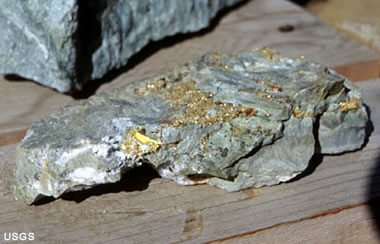
Lode gilded: Gold ore from the Olinghouse epithermal eolith. When gilded is plant in the rocks where information technology crystallized, information technology is known as a "lode deposit." USGS image.
The Rewards of Finding Gold
Anyone who pans for gold hopes to be rewarded by the glitter of colors in the fine material collected in the bottom of the pan. Although the exercise and outdoor activity experienced in prospecting are rewarding, there are few thrills comparable to finding gold.
Even an assay written report showing an appreciable content of gold in a sample obtained from a lode deposit is exciting. The would-be prospector hoping for financial gain, even so, should advisedly consider all the pertinent facts earlier deciding on a prospecting venture.
Few Prospectors Find Valuable Gilt Deposits
Simply a few prospectors among the many thousands who searched the western part of the United states ever found a valuable deposit. Most of the gold mining districts in the West were located past pioneers, many of whom were experienced gold miners from the southern Appalachian region, but fifty-fifty in colonial times simply a small proportion of the aureate seekers were successful.
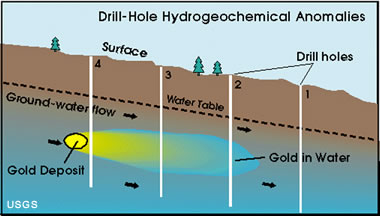
Hydrogeochemical prospecting for gold: Groundwater collected from wells, springs, and drill holes may provide clues to the presence of subsurface gilded deposits. As groundwater flows through the deposit, minute amounts of gold are leached from the rocks. These can sometimes exist detected in groundwater samples collected from wells located down gradient from the deposit. USGS prototype.
The US Has Been Heavily Prospected
Over the past several centuries the country has been thoroughly searched by prospectors.
No other country in the world has been more than thoroughly prospected.
During the low of the 1930's, prospectors searched the ameliorate known gold-producing areas throughout the Nation, especially in the West, and the little-known areas as well. The results of their activities take never been fully documented. But incomplete records indicate that an extremely pocket-size percentage of the full number of active prospectors supported themselves past gold mining.
Of the few meaning discoveries reported, nearly all were made by prospectors of long experience who were familiar with the regions in which they were working.
Gold Panning made easy: Gary Smith, a gold panner from British Colombia with xl years of experience, demonstrates his panning methods and gives advice. More aureate panning videos.
Prospect Where Gold Has Been Institute Earlier
The lack of outstanding success in spite of the nifty increase in prospecting during the depression in the 1930'south confirms the opinion of those most familiar with the occurrence of gold and the evolution of aureate mining districts is that the best chances of success lie in systematic studies of known productive areas rather than in efforts to discover gold in hitherto unproductive areas.
The evolution of new, highly sensitive, and relatively cheap methods of detecting golden, however, has greatly increased the possibility of discovering gilt deposits which are too low form to have been recognized earlier by the prospector using only a gold pan. These may be large enough to exist exploited by mod mining and metallurgical techniques.
The Carlin mine near Carlin, Nevada, produced gold from a large low-grade eolith that was opened in 1965 after intensive scientific and technical work had been completed. Similar investigations have led to the discovery of a Carlin-type gold eolith in Jerritt Canyon, Nevada.
ADVERTISEMENT
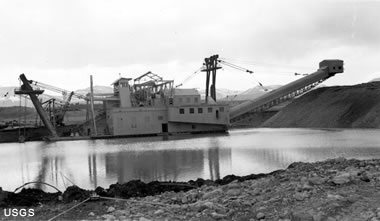
Gilded dredge: A floating gold dredge operating near Fairplay, Colorado in 1950. Machines like this could dredge up hundreds of tons of sediment per 24-hour interval and process it to remove the golden. USGS image.
Many Placer Deposits Have Been Worked - Twice
Many believe that it is possible to make wages or better by panning gold in the streams of the West, particularly in regions where placer mining formerly flourished. Yet, well-nigh placer deposits have been thoroughly reworked at least twice - offset by Chinese laborers, who arrived shortly later on the initial boom periods and recovered gold from the lower class deposits and tailings left by the starting time miners, and later by afoot miners during the 1930's.
Geologists and engineers who systematically investigate remote parts of the country find pocket-sized placer diggings and old prospect pits whose number and broad distribution imply few, if any, recognizable surface indications of metal-bearing deposits were disregarded by the before miners and prospectors.

Convergent plate boundaries are the plate tectonic setting of many gold deposits. There, magma produced by the melting of descending lithosphere rises as magma chambers and crystallizes shut to the surface. Gold in these hot environments is often dissolved in superheated water and carried away from the magma bedchamber along faults and fractures. The water temperature is very high near the magma sleeping room but drops with altitude. As the water travels farther from the magma chamber, gold starts to crystallize out inside the fracture to produce a vein gilded deposit. USGS image.
Fiscal Challenges of Aureate Prospecting
One who contemplates prospecting for gilded should realize that a successful venture does not necessarily hateful large profits even if the discovery is developed into a producing mine. Although the price of golden has increased significantly since 1967 when the fixed price of $35 an ounce was terminated, the increases in the cost of virtually every supply and service item needed in prospecting and mining ventures have kept profit margins at moderate levels, particularly for the small-scale mine operator.
In general, wide fluctuations in the cost of gold are not uncommon, whereas inflationary pressures are more than persistent. The producer of gold, therefore, faces uncertain economical problems and should be enlightened of their furnishings on his operation.
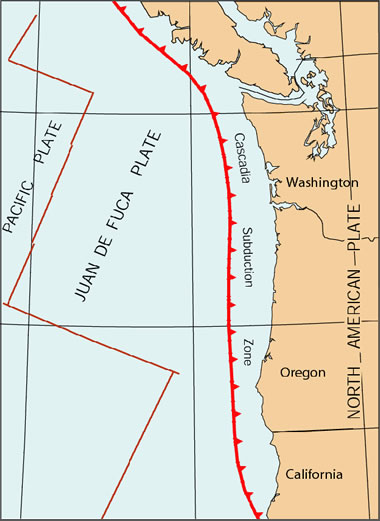
Convergent boundary map: A present-day convergent boundary is located forth the Pacific Northwest portion of the United States and extends north along the declension of Canada. Volcanic action at that place will produce the gold deposits of the time to come. Gold deposits being mined today were produced by ancient action on current plate boundaries or ancient activity on boundaries that are no longer active. USGS epitome.
Knowledge of Laws and Property Ownership
Today's prospector must determine where prospecting is permitted and be enlightened of the regulations nether which he is allowed to search for golden and other metals. Permission to enter upon privately owned land must exist obtained from the state possessor. Determination of land buying and location and contact with the owner can be a time-consuming chore but one which has to be done earlier prospecting tin can begin.
Most country in the United states of america is off-limits for gold prospecting. The gilded beneath these lands is owned by individuals, companies or governments. Anyone who prospects for gold (or whatever other mineral) tin can exist prosecuted for theft if they remove gilded (or any other mineral) from country on which the mineral resource is not open to prospecting. See our article on the "Legal Aspects of Rock, Mineral and Fossil Collecting".
Determination of the location and extent of public lands open to mineral entry for prospecting and mining purposes also is a time consuming but necessary requirement. National parks, for example, are closed to prospecting. Certain lands under the jurisdiction of the Forest Service and the Bureau of State Management may exist entered for prospecting, but sets of rules and regulations govern entry. The following statement from a pamphlet issued in 1978 by the U.Southward. Department of the Interior and entitled "Staking a mining claim on Federal Lands" responds to the question "Where May I Prospect?"
"There are notwithstanding areas where you lot may prospect, and if a discovery of a valuable, locatable mineral is fabricated, you may stake a claim. These areas are mainly in Alaska, Arizona, Arkansas, California, Colorado, Florida, Idaho, Louisiana, Mississippi, Montana, Nebraska, Nevada, New United mexican states, North Dakota, Oregon, South Dakota, Utah, Washington, and Wyoming.
Such areas are mainly unreserved, unappropriated Federal public lands administered past the Bureau of State Management (BLM) of the U.S. Department of the Interior and in national forests administered by the Forest Service of the U.Southward. Department of Agriculture. Public land records in the proper BLM Country Office will bear witness you which lands are closed to mineral entry under the mining laws.
These offices keep upwardly-to-appointment country status plats that are bachelor to the public for inspection. BLM is publishing a serial of surface and mineral ownership maps that depict the general ownership pattern of public lands. These maps may exist purchased at most BLM Offices. For a specific tract of state, it is advisable to bank check the official land records at the proper BLM Country Role."
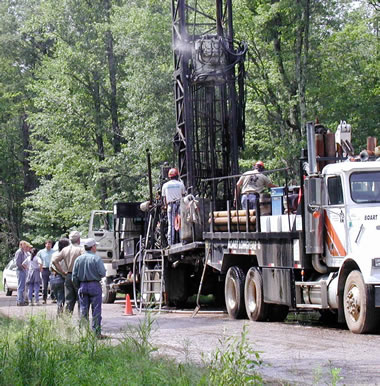
Cadre drilling for gilt: Cadre drilling the Bend massive sulfide deposit, located in the Medford District of the Chequamegon National Forest, Michigan. Information technology is a small, metallic-rich sulfide body hosted by Early Proterozoic Penokean volcanics. The mineralized horizon subcrops beneath 100-120 feet of glacial cover, and consists of massive pyrite with varying amounts of chalcopyrite, tetrahedrite-tenantite, bornite, arsenopyrite, chalcocite, and rare gold-silverish tellurides. USGS image.
Pocket-sized Prospectors and Total Gold Production
Successful gilded mining under present conditions is a big-scale operation, utilizing plush and sophisticated machinery capable of handling many tons of depression-grade ore each twenty-four hour period. The grizzled prospector with a burro is no longer a significant participant in the search for mineral deposits, and the small producer accounts for but a minor share of the full production of metals including gilt.
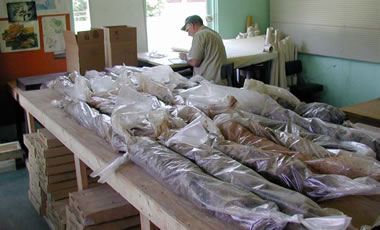
Gold core at the lab: The core recovered from the Bend massive sulfide deposit (see drilling photo above) was 3" in diameter and was recovered in 10-human foot sections. The sections were extracted from the drill stem into plastic bags and taken to a laboratory for careful examination, sampling and analysis. USGS image.
Study, Persistence and Financial Backing
Some degree of success in finding gold still remains for those choosing favorable areas afterward a careful written report of mining records and the geology of the mining districts. Serious prospecting should not be attempted by anyone without sufficient capital to support a long and possibly discouraging campaign of preliminary work.
The prospective aureate seeker must have ample funds to travel to and from the region he selects to prospect and to support the venture. He must be prepared to undergo physical hardships, possess a car capable of traveling the roughest and steepest roads, and non exist discouraged past repeated disappointments. Even if a discovery of value is non found, the venture will have been interesting and challenging.

Fortitude Mine in Nevada produced about ii million ounces of gold betwixt 1984 and 1993. USGS image.
Public Data for Gold Prospectors
Locations of important gold-producing districts of the United States are shown in some of the reports of the United States Geological Survey listed at the bottom of this folio. Geological surveys of the main gold-producing States where additional information may be obtained also are listed. Information may be obtained, too, from U.S. Bureau of Mines State Liaison offices located in the uppercase cities of virtually States. In that location are also a large number of layman'due south books about aureate that describe golden deposits and aureate prospecting.
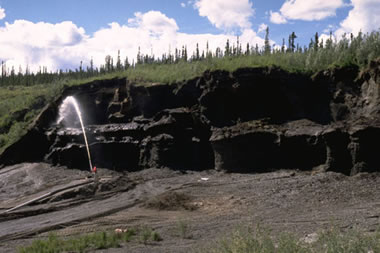
Hydraulic placer mining at Lost Chicken Loma Mine, near Chicken, Alaska. The firehose blasts the sediment outcrop, washing abroad sand, clay, gravel and aureate particles. The material is and so processed to remove the gold. USGS paradigm.
The Geology of Placer Deposits
A placer eolith is a concentration of a natural material that has accumulated in unconsolidated sediments of a stream bed, beach, or residual eolith. Aureate derived by weathering or other process from lode deposits is likely to accumulate in placer deposits considering of its weight and resistance to corrosion.
In addition, its characteristically dominicus-yellow colour makes it easily and quickly recognizable even in very small-scale quantities. The gold pan or miner'southward pan is a shallow sheet-atomic number 26 vessel with sloping sides and apartment bottom used to wash gold-bearing gravel or other material containing heavy minerals.
The procedure of washing material in a pan, referred to as "panning," is the simplest and most commonly used and least expensive method for a prospector to separate golden from the silt, sand, and gravel of the stream deposits. It is a slow, back-breaking task and merely with practice does one become practiced in the operation.
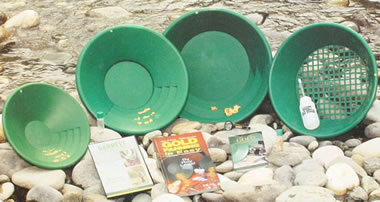
Gold Panning Kits can be purchased by people who want to attempt their manus at finding gold. This kit provides the tools, plus information technology helps y'all build the knowledge and skills needed for success at finding gilt.
California Placer Deposits
Many placer districts in California have been mined on a large calibration as recently as the mid-1950'southward. Streams draining the rich Mother Lode region--the Feather, Mokelumne, American, Cosumnes, Calaveras, and Yuba Rivers--and the Trinity River in northern California have full-bodied considerable quantities of golden in gravels. In addition, placers associated with gravels that are stream remnants from an older erosion wheel occur in the same general surface area.
Alaska Placer Deposits
Much of the gold produced in Alaska was mined from placers. These deposits are widespread, occurring along many of the major rivers and their tributaries. Some ocean beach sands likewise have been productive. The chief placer-mining region has been the Yukon River basin which crosses central Alaska.
Dredging operations in the Fairbanks district have been the most productive in the Country. Beach deposits in the Nome district in the due south-central part of the Seward Peninsula rank second among productive placer deposits of Alaska. Other highly productive placers have been found in the drainage basin of the Copper River and of the Kuskokwim River.
Montana Placer Deposits
In Montana, the chief placer-mining districts are in the southwestern part of the State. The most productive placer deposit in the State was at Alder Gulch near Virginia City in Madison Canton. Other important placer localities are on the Missouri River in the Helena mining district. The famous Last Chance Gulch is the site of the city of Helena.
There are many districts farther due south on the headwaters and tributaries of the Missouri River, especially in Madison Canton which ranks third in total gold production in the Land. Gold has been produced at many places on the headwaters of the Clark Fork of the Columbia River, particularly in the vicinity of Butte. Placer production from the Butte district, however, has been over-shadowed by the full output of byproduct gold recovered from the mining of lode deposits of copper, lead, and zinc.
Idaho Placer Deposits
Idaho was in one case a leading placer-mining Country. 1 of the chief dredging areas is in the Boise Bowl, a few miles northeast of Boise, in the west-central part of the Country. Other placer deposits are located forth the Salmon River and on the Clearwater River and its tributaries, particularly at Elk City, Pierce, and Orofino. Extremely fine-grained (or "flour") gold occurs in sand deposits along the Snake River in southern Idaho.
Colorado Placer Deposits
Placers in Colorado have been mined in the Fairplay district in Park County, and in the Breckenridge commune in Summit Canton. In both areas large dredges were used during the top action in the 1930's.
Oregon Placer Deposits
The nigh important mining regions of Oregon are in the northeastern office of the State where both lode and placer gold take been found. Placer gold occurs in many streams that bleed the Blue and Wallowa Mountains. One of the most productive placer districts in this expanse is in the vicinity of Sumpter, on the upper Powder River. The Burnt River and its tributaries accept yielded aureate.
Farther to the west, placer mining (particularly dredging) has been carried on for many years in the John Day River valley. In southwestern Oregon, tributaries of the Rogue River and neighboring streams in the Klamath Mountains have been sources of placer aureate. Among the main producing districts in this region are the Greenback district in Josephine County and the Applegate district in Jackson Canton.
S Dakota and Washington
Small-scale amounts of placer gilt have been produced in S Dakota (the Black Hills region, particularly in the Deadwood area, and on French Creek, nearly Custer) and in Washington (on the Columbia and Snake Rivers and their tributaries).
Nevada, Arizona, New Mexico
In addition to these localities, placer gold occurs along many of the intermittent and imperceptible streams of barren regions in Nevada, Arizona, New United mexican states, and southern California. In many of these places a big reserve of low-grade placer aureate may exist, but the lack of a permanent water supply for conventional placer mining operations requires the use of expensive dry or semidry concentrating methods to recover the gold.
Eastern US Placer Deposits
In the eastern States, express amounts of golden have been washed from some streams draining the eastern slope of the southern Appalachian region in Maryland, Virginia, N Carolina, S Carolina, Georgia, and Alabama. Many saprolite (disintegrated somewhat decomposed rock that lies in its original place) deposits in this general region also have been mined by placer methods.
Small-scale quantities of gold have been mined past placer methods in some New England States. Additional placer deposits may be discovered in the East, but prospecting will require substantial expenditures of fourth dimension and money. The deposits probably will be low class, difficult to recognize, and costly to explore and sample. Moreover, about of the state in the East is privately owned, and prospecting tin be done only with the prior permission and agreement of the land owner.
Gold Books and Panning Supplies
Looking for gold? Nosotros have over fifty unlike gold books and gold maps that show where gilt has been plant in the by and provide instruction on aureate prospecting methods. Besides available are gold pans in a variety of sizes and gold panning kits which include everything that you lot volition need.Lode Gilded
Lode golden occurs within the solid rock in which it was deposited. Areas likely to comprise valuable lode deposits of golden take been explored so thoroughly that the inexperienced prospector without ample capital has little run a risk of discovering a new lode worth developing. Nigh time to come discoveries of workable lode golden ore probably will result from continued investigations in areas known to be productive in the by. The districts in which such new discoveries of gold may exist possible are too numerous to be listed in particular in this article.
Some of the famous districts are: in California, the Alleghany, Sierra City, Grass Valley, and Nevada City districts, and the Female parent Lode belt; in Colorado, the Cripple Creek, Telluride, Silverton, and Ouray districts; in Nevada, the Goldfield, Tonopah, and Comstock districts; in South Dakota, the Pb commune in the Black Hills; and in Alaska, the Juneau and Fairbanks districts. Deposits in these districts generally are gilded-quartz lodes.
| Sources of Gold Information |
| There are many publications of interest to those seeking more than data about gilt. The United states Geological Survey has published lots of reports nigh general geology and mineral resource for nigh of the major gold-producing areas. In improver most state geological surveys where gold production has occurred have compiled reports and maps to document the full general geology, deposits and mining activity. In that location are also lots of prospecting guides and maps geared to amateur prospectors. |
Lode Gold Areas Have Been Thoroughly Prospected
Prospecting for lode deposits of gold is not the relatively simple task it one time was considering near outcrops or exposures of mineralized rock have been examined and sampled. Today'due south prospector must examine not only these exposures, simply also broken rock on mine dumps and exposures of mineralized stone in attainable mine workings.
Undiscovered Gold is Finely Disseminated
Golden, if nowadays, may not be visible in the rock, and detection will depend on the results of laboratory analyses. Unremarkably, samples of three to 5 pounds of representative mineralized rock will exist sent to a commercial analytical laboratory or assay office for assay. Plain, noesis about the geological nature of gilt deposits and specially of the rocks and deposits in the area of interest will aid the prospector.
Find Other Topics on Geology.com:
 Rocks: Galleries of igneous, sedimentary and metamorphic rock photos with descriptions. |  Minerals: Data nearly ore minerals, gem materials and stone-forming minerals. |
 Volcanoes: Articles nearly volcanoes, volcanic hazards and eruptions past and present. |  Gemstones: Colorful images and manufactures about diamonds and colored stones. |
 Full general Geology: Manufactures about geysers, maars, deltas, rifts, common salt domes, water, and much more! |  Geology Store: Hammers, field bags, mitt lenses, maps, books, hardness picks, gilt pans. |
 |  Diamonds: Learn about the backdrop of diamond, its many uses, and diamond discoveries. |
Source: https://geology.com/usgs/gold-prospecting/
Posted by: stewartrefspot.blogspot.com


0 Response to "How To Find Gold In The Mountains"
Post a Comment